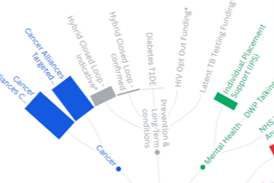Speech recognition technology helped to cut turnaround times at a struggling histopathology laboratory, which will have a positive impact on patient care and the trust’s finances, writes Dean Harmse

It is no secret that today’s healthcare system is in desperate need of a makeover if it is to continue supplying care for our growing and ageing population. This is compounded and complicated by the need for the NHS to make £20bn in cost savings by 2015, and the UK government’s directive to move from paper to paperless by 2018.
‘By deploying speech recognition solutions and an improved workflow, the backlog was cleared completely within four months’
These are driving healthcare providers to rapidly invest in electronic health records to put “care” back into healthcare but what role can speech technology play in enabling that to happen? In our histopathology laboratory’s experience, it is a significant one.
The laboratory was faced with a backlog of approximately 600 cases awaiting reporting. Turnaround times of more than 10 weeks were typical. To resolve these delays we started by reviewing our internal workflow processes and evaluating technology that could reduce the build-up of histology backlogs.
Simply put, the sooner a histological diagnosis can be made, the sooner the patient can receive not only the next level of treatment, but also the right treatment.
A streaming process was introduced that identified priority cases, set up a new workflow for cases and scheduled tasks more efficiently. The final process involved the deployment of a speech recognition solution.
- Unplugging the clinical letter bottleneck
- A belated cure for clinical correspondence’s ills
- Sign up to receive the latest innovation news and resources by email
Saving time, saving money
Perhaps the most important proof point that demonstrates the effectiveness of deploying speech recognition solutions in conjunction with an improved workflow, is that the backlog was cleared completely within four months.
The seven day turnaround time improved from 38 per cent to 87 per cent, while 10 day turnaround times improved from 48 per cent to 94 per cent within four months – both exceeding the contemporary national targets of 80 per cent.
‘Detailed reports are now created accurately and in real time. There are no delays waiting for a secretary to type the report’
In day to day use, pathologists benefit from speech recognition being time neutral; detailed reports are now created accurately and in real time, according to the pathologist’s convenience.
There are no delays waiting for a secretary to type the report, which prevents a typing backlog from building up. The secretary is then freed up to conduct tasks that ease the burden on the pathologist, allowing the pathologist to concentrate on the reporting of cases rather than undertaking administrative tasks.
Having also introduced speech recognition for the biomedical scientist cut-up, we are enjoying savings that equate to one assistant per session, or the equivalent of seven hours a day.
Other time saving achievements result from the automatic entering of data into our laboratory information system, saving us approximately 45 minutes a day.
This shows that, when managed properly, speech recognition saves time and human resources. It is no surprise then that I hear pathologists saying, “Once you use it, you never go back.”
Feel the fear
Despite this positive story, some people have had mixed experiences with older speech recognition systems. Just as there has been significant progress in medical knowledge in the last two decades, so there have been significant strides in the accuracy and ease of use of today’s speech recognition applications.
While speech recognition’s accuracy is not an issue – it can cope with regional accents – there are some issues to consider and overcome when deploying it. The greatest of these, perhaps unsurprisingly, is resistance to change and the fear of new technology.
‘The technology is beginning to remove patients from backlogs and is putting them back at the centre of care’
Fingers may have been burned in the past through false starts, usually the result of a piecemeal introduction combined with a lack of adequate training. Others have faced integration prosblems with existing software. Our experience proves that these challenges, whether change management or technology related, can be overcome.
To do so, and to make the deployment of speech recognition as seamless as possible, the need to work with an experienced partner cannot be emphasised enough.
Implementing speech recognition helped us not just improve patient care, but also win the NHS Innovation Challenge Prize this year, which was worth £50,000. This money was spent on further improving our department.
The future for healthcare IT is exciting and speech recognition has the potential to help medical professionals more quickly navigate electronic health record, data, diagnosis and prescription options.
Virtual assistants will help medical professionals embrace this inevitable shift to a digital workflow. Most important of all, and as we have seen in the laboratory, speech technology is beginning to remove patients from backlogs and is putting them back where they should always be – at the centre of care.
Dean Harmse is the clinical lead for specimen dissection at Plymouth Hospitals Trust



























No comments yet